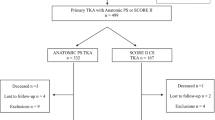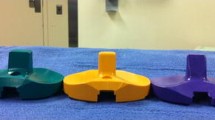Abstract
Introduction
High-grade varus osteoarthrosis (OA) is characterized by a pronounced intra-articular varus deformity and associated insufficiency of the lateral ligamentous complex. When performing a total knee arthroplasty (TKA) in such a knee, traditionally the alignment is restored to neutral, and the medial soft tissue structures are released to compensate for the lateral laxity and balance the joint. However, another option would be to leave the medial soft tissues untouched and accept the lateral laxity but to compensate for it using an ML-stabilized constrained-condylar knee (CCK) design. Our aim was to prove our hypothesis that such knees would demonstrate better clinical stability and better functionality as well as subjective outcome scores.
Materials and methods
We searched our bicenter database of 912 primary TKAs (from 2016 to 2019) for primary TKA patients with a preoperative varus alignment of > 8°. After inclusion, 60 patients were divided into three groups by implant design: CCK (n = 21), posterior-stabilized (PS) (n = 20) and cruciate-retaining (CR) (n = 19). Oxford Knee Score (OKS), Forgotten Joint Score (FJS), Knee Society Score (KSS), UCLA-activity score, ML instability scores and both radiographic and clinical data were compared between groups.
Results
ML stability was significantly better in CCK designs (86% grade 0) compared to CR (37% grade 0) (p = 0.004) but not PS (70% grade 0) designs. No grade II instability was present in CCK and PS implants compared to 16% of CR implants. KSS and UCLA-activity score were higher in CCK designs compared to PS (p = 0.027, p = 0.041) and CR designs (p < 0.001, p = 0.007). OKS and FJS were higher in CCK designs compared to CR (p = 0.025, p = 0.008) but not to PS.
Conclusion
The use of a CCK design to compensate for the lateral laxity in high-grade varus OA knees allowed to refrain from a medial release. CCK designs displayed improved clinical stability and better functionality as well as subjective outcome scores compared to less-constrained designs.
Similar content being viewed by others
References
Noyes FR, Barber-Westin SD, Hewett TE (2000) High tibial osteotomy and ligament reconstruction for varus angulated anterior cruciate ligament-deficient knees. Am J Sports Med 28(3):282–296
Wang X, Malik A, Bartel DL, Wright TM, Padgett DE (2016) Load sharing among collateral ligaments, articular surfaces, and the tibial post in constrained condylar knee arthroplasty. J Biomech Eng 138(8)
Chang A, Hayes K, Dunlop D et al (2004) Thrust during ambulation and the progression of knee osteoarthritis. Arthritis Rheum 50(12):3897–3903
Thienpont E, Parvizi J (2016) A new classification for the varus knee. J Arthroplasty 31(10):2156–2160
Bellemans J, Vandenneucker H, Vanlauwe J, Victor J (2010) The influence of coronal plane deformity on mediolateral ligament status: an observational study in varus knees. Knee Surg Sports Traumatol Arthrosc 18(2):152–156
Benjamin J (2006) Component alignment in total knee arthroplasty. Instr Course Lect 55:405–412
Bellemans J, Colyn W, Vandenneucker H, Victor J (2012) The Chitranjan Ranawat award: is neutral mechanical alignment normal for all patients? The concept of constitutional varus. Clin Orthop Relat Res 470(1):45–53
Fang DM, Ritter MA, Davis KE (2009) Coronal alignment in total knee arthroplasty: just how important is it? J Arthroplasty 24(6 Suppl):39–43
Baldini A, Castellani L, Traverso F, Balatri A, Balato G, Franceschini V (2015) The difficult primary total knee arthroplasty: a review. Bone Jt J 97-B(10 Suppl A):30–39
Martin JR, Fehring KA, Watts CD, Levy DL, Springer BD, Kim RH (2017) Coronal alignment predicts the use of semi-constrained implants in contemporary total knee arthroplasty. Knee 24(4):863–868
Ye CY, Xue DT, Jiang S, He RX (2016) Results of a second-generation constrained condylar prosthesis in complex primary and revision total knee arthroplasty: A mean 5.5-year follow-up. Chin Med J (Engl) 129(11):1334–1339
Lachiewicz PF, Soileau ES (2011) Results of a second-generation constrained condylar prosthesis in primary total knee arthroplasty. J Arthroplasty 26(8):1228–1231
Puah KL, Chong HC, Foo LSS, Lo NN, Yeo SJ (2018) Clinical and functional outcomes: primary constrained condylar knee arthroplasty compared with posterior stabilized knee arthroplasty. J Am Acad Orthop Surg Glob Res Rev 2(2):e084
Sabatini L, Risitano S, Rissolio L, Bonani A, Atzori F, Massè A (2017) Condylar constrained system in primary total knee replacement: our experience and literature review. Ann Transl Med 5(6):135
Dayan I, Moses MJ, Rathod P, Deshmukh A, Marwin S, Dayan AJ (2020) No difference in failure rates or clinical outcomes between non-stemmed constrained condylar prostheses and posterior-stabilized prostheses for primary total knee arthroplasty. Knee Surg Sports Traumatol Arthrosc 28(9):2942–2947
Deshmukh AJ, Rathod PA, Moses MJ, Snir N, Marwin SE, Dayan AJ (2016) Does a non-stemmed constrained condylar prosthesis predispose to early failure of primary total knee arthroplasty? Knee Surg Sports Traumatol Arthrosc 24(10):3194–3199
Dawson J, Fitzpatrick R, Murray D, Carr A (1998) Questionnaire on the perceptions of patients about total knee replacement. J Bone Jt Surg Br 80(1):63–69
Behrend H, Giesinger K, Giesinger JM, Kuster MS (2012) The “forgotten joint” as the ultimate goal in joint arthroplasty: validation of a new patient-reported outcome measure. J Arthroplasty 27(3):430-436.e431
Noble PC, Scuderi GR, Brekke AC et al (2012) Development of a new Knee Society scoring system. Clin Orthop Relat Res 470(1):20–32
Zahiri CA, Schmalzried TP, Szuszczewicz ES, Amstutz HC (1998) Assessing activity in joint replacement patients. J Arthroplasty 13(8):890–895
Caton J, Deschamps G, Chambat P, Lerat JL, Dejour H (1982) Patella infera Apropos of 128 cases. Rev Chir Orthop Reparatrice Appar Mot 68(5):317–325
Kellgren JH, Lawrence JS (1957) Radiological assessment of osteo-arthrosis. Ann Rheum Dis 16(4):494–502
Vyskocil P, Gerber C, Bamert P (1999) Radiolucent lines and component stability in knee arthroplasty. Standard versus fluoroscopically-assisted radiographs. J Bone Jt Surg Br 81(1):24–26
Ghosh KM, Manning WA, Blain AP et al (2016) Influence of increasing construct constraint in the presence of posterolateral deficiency at knee replacement: a biomechanical study. J Orthop Res 34(3):427–434
Athwal KK, Willinger L, Manning W, Deehan D, Amis AA (2020) A constrained-condylar fixed-bearing total knee arthroplasty is stabilised by the medial soft tissues. Knee Surg Sports Traumatol Arthrosc 29:659–667
Cholewinski P, Putman S, Vasseur L et al (2015) Long-term outcomes of primary constrained condylar knee arthroplasty. Orthop Traumatol Surg Res 101(4):449–454
Nam D, Umunna BP, Cross MB, Reinhardt KR, Duggal S, Cornell CN (2012) Clinical results and failure mechanisms of a nonmodular constrained knee without stem extensions. HSS J 8(2):96–102
Rai S, Liu X, Feng X et al (2018) Primary total knee arthroplasty using constrained condylar knee design for severe deformity and stiffness of knee secondary to post-traumatic arthritis. J Orthop Surg Res 13(1):67
Funding
This study is part of Limburg Clinical Research Center supported by Hasselt University, Ziekenhuis Oost-Limburg and Jessa Hospital.
Author information
Authors and Affiliations
Contributions
Every author was involved in each part of this study including. Conception or design of the work. Data collection. Data analysis and interpretation. Drafting the article. Critical revision of the article. Final approval of the version to be published.
Corresponding author
Ethics declarations
Conflict of interest
The author(s) declare that they have no competing interests.
Ethical approval
Approval for this study was obtained by the Ethical Committee at B (19/0097U, B-nr: B371202042789).
Informed consent
An informed consent was given by each participant of the study.
Additional information
Publisher's Note
Springer Nature remains neutral with regard to jurisdictional claims in published maps and institutional affiliations.
Rights and permissions
About this article
Cite this article
Colyn, W., Neirynck, J., Vanlommel, E. et al. Primary constrained-condylar-knee designs outperform posterior-stabilized and cruciate-retaining designs in high-grade varus osteoarthritic knees during short-term follow-up: a pilot study. Arch Orthop Trauma Surg 143, 1593–1598 (2023). https://doi.org/10.1007/s00402-022-04447-9
Received:
Accepted:
Published:
Issue Date:
DOI: https://doi.org/10.1007/s00402-022-04447-9




